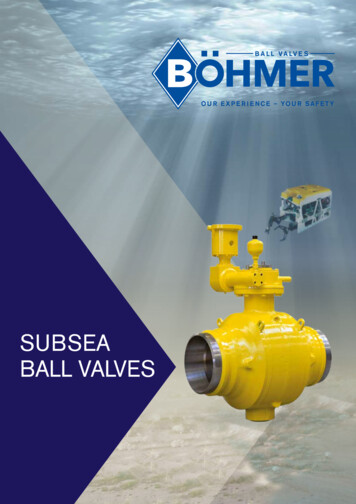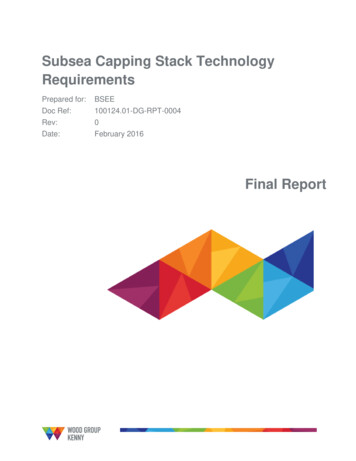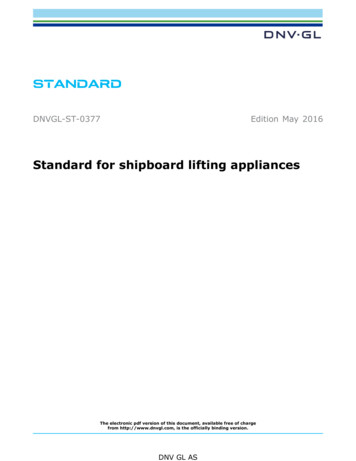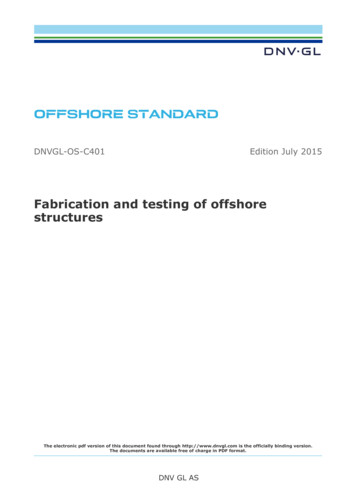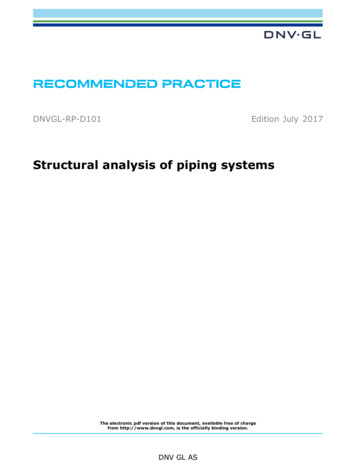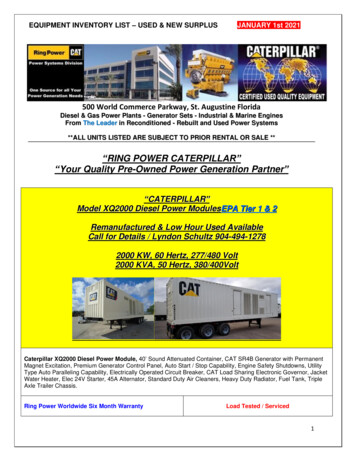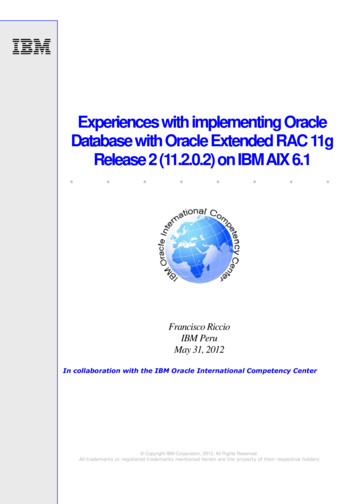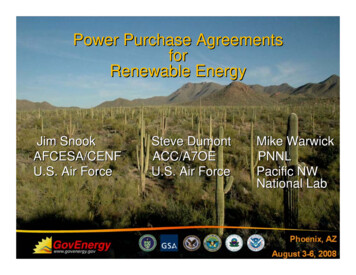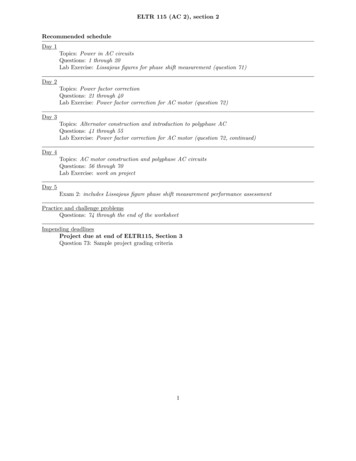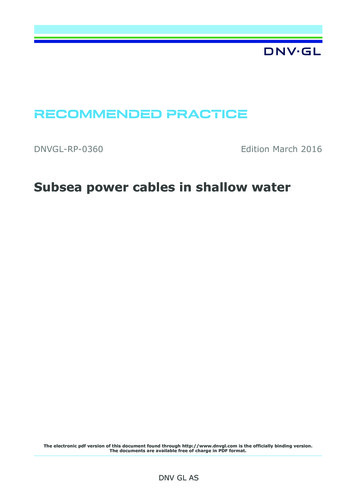
Transcription
RECOMMENDED PRACTICEDNVGL-RP-0360Edition March 2016Subsea power cables in shallow waterThe electronic pdf version of this document found through http://www.dnvgl.com is the officially binding version.The documents are available free of charge in PDF format.DNV GL AS
FOREWORDDNV GL recommended practices contain sound engineering practice and guidance. DNV GL AS March 2016Any comments may be sent by e-mail to rules@dnvgl.comThis service document has been prepared based on available knowledge, technology and/or information at the time of issuance of this document. The use of thisdocument by others than DNV GL is at the user's sole risk. DNV GL does not accept any liability or responsibility for loss or damages resulting from any use ofthis document.
GeneralThis document supersedes DNV-RP-J301, February 2014.Text affected by the main changes in this edition is highlighted in red colour. However, if the changesinvolve a whole chapter, section or sub-section, normally only the title will be in red colour.On 12 September 2013, DNV and GL merged to form DNV GL Group. On 25 November 2013 Det NorskeVeritas AS became the 100% shareholder of Germanischer Lloyd SE, the parent company of the GL Group,and on 27 November 2013 Det Norske Veritas AS, company registration number 945 748 931, changed itsname to DNV GL AS. For further information, see www.dnvgl.com. Any reference in this document to “DetNorske Veritas AS”, “Det Norske Veritas”, “DNV”, “GL”, “Germanischer Lloyd SE”, “GL Group” or any otherlegal entity name or trading name presently owned by the DNV GL Group shall therefore also be considereda reference to “DNV GL AS”.Main changes March 2016 Sec.1 General— [1.2.3] Addition of the DNVGL-ST-0126 as informative standard.— [1.2.4] Addition of the DNVGL-RP-0005/RP-C203 and CIGRÉ Technical Brochure 610 and 623 asinformative guidelines.— [1.2.5] Addition of the guidance of CBRA methodology as informative reference.— [1.3.2] Revision of the definitions “bird caging”, “sealing” and “trenching”. Addition of the definition“departure angle”. Sec.3 Concept development— [3.2.4.2] Addition of the guidance notes regarding cable design and removing the use of up-rating / derating factors for current rating. Sec.4 Design— [4.6.3.2] Addition of CBRA methodology for determining the burial depth.— [4.7.4.7] Addition of the requirement on corrosion protection. Sec.6 Installation— [6.1.2] Addition of the guidance note regarding possible change of installation sequencing.[6.2.4.2] Addition of the guidance note regarding minimum clearances between the anchors and thesubsea infrastructure. Sec.7 Operation and maintenance— [7.3.3] Addition of recommendation for recording the as-built positions of cables.— [7.5.3] Addition of recommendation for fault location methods.In addition, the layout of this document has been converted to layout for DNV GL service documentation.Editorial correctionsIn addition to the above stated main changes, editorial corrections may have been made.Recommended practice, DNVGL-RP-0360 – Edition March 2016DNV GL ASPage 3Changes – currentCHANGES – CURRENT
This recommended practice was developed by a Joint Industry Project (JIP). The work was performed byDNV and discussed in regular project meetings and workshops with individuals from the participatingcompanies. They are hereby acknowledged for their valuable and constructive input. In case consensus hasnot been achievable, DNV has sought to provide acceptable compromise.Sponsors of the JIP included the following organisations:Bohlen & DoyenBoskalis OffshoreDONG EnergyElectrabel GDF SUEZIberdrola S.A.Inch Cape (Repsol, EDPR)JDR Cable SystemsNorddeutsche SeekabelwerkeOffshore Marine ManagementSiem Offshore ContractorsTekmar EnergyTideway Offshore SolutionsVan Oord Offshore Wind Projects B.V.Visser & Smit Marine ContractingFurther organisations have participated in the review process. DNV is grateful for the valuable co-operationsand discussions with individuals in these organisationsRecommended practice, DNVGL-RP-0360 – Edition March 2016DNV GL ASPage 4Changes – currentAcknowledgement
CHANGES – CURRENT . 3Sec.1Sec.2Sec.3General . 101.1General .101.1.1Introduction . 101.1.2Objectives . 101.1.3Scope and application. 101.1.4Alternative methods and procedures. 111.1.5Structure of recommended practice . 111.2References .121.2.1Applicability . 121.2.2Standards - normative. 121.2.3Standards - informative . 121.2.4Guidelines - informative. 131.2.5Other references - informative. 151.3Definitions .151.3.1Verbal forms . 151.3.2Definitions . 151.4Abbreviations and symbols .271.4.1Abbreviations . 271.4.2Symbols . 29Design philosophy . 302.1General .302.1.1Objective . 302.1.2Application. 302.1.3Stakeholders and interfaces . 302.2Safety2.2.12.2.22.2.32.2.42.2.52.3Design format .342.3.1Approach . 342.3.2System analysis. 34philosophy .31General . 31Safety objective. 32Systematic review of risks. 32Dependability and risk based design . 33Quality assurance . 33Concept development. 393.1General .393.2Conceptual design.393.2.1Systematic approach . 393.2.2Project layout . 393.2.3Electrical system studies . 403.2.4Preliminary cable selection . 413.2.5Preliminary engineering . 423.3Cable route study .433.3.1General . 433.3.2Route selection and landing. 443.3.3Regulatory requirements. 443.3.4Commercial operations, restricted areas, obstructions. 453.3.5Geology and seismicity . 473.3.6Meteorological and marine conditions . 48Recommended practice, DNVGL-RP-0360 – Edition March 2016DNV GL ASPage 5ContentsCONTENTS
3.4Sec.4Sec.5Natural environment . 50Cable route survey .523.4.1General . 523.4.2Onshore surveys. 523.4.3Offshore surveys . 533.4.4Determination of site conditions. 56Design . 584.1General .584.2Cable system design conditions .584.2.1General . 584.2.2Project description . 584.2.3Functional requirements . 584.2.4Design basis. 594.3Cable system design .594.3.1Detailed design. 594.3.2Installation engineering . 604.4Cable system.614.4.1Power cables . 614.4.2Power cable accessories. 644.4.3Optical fibres. 654.5Cable route .664.5.1General . 664.5.2Parallel routing of power cables . 674.5.3Proximity to existing infrastructure. 684.5.4Crossing of existing infrastructure . 684.6Cable protection.694.6.1General . 694.6.2Additional armour . 704.6.3Cable burial . 704.6.4Non-burial cable protection . 744.7Cable interface at fixed offshore units .764.7.1General . 764.7.2Offshore unit . 764.7.3Interface between cable and offshore unit . 814.7.4Interface components. 844.7.5Scour and scour protection. 874.8Landfall .894.8.1General . 894.8.2Open-cut trench . 914.8.3Horizontal directional drilling . 924.8.4Onshore jointing location . 93Manufacturing . 955.1General .955.1.1Quality system and workmanship . 955.1.2Inspection. 955.2Cable manufacturing and testing .965.2.1General . 965.2.2Power cable type tests. 965.2.3Power cable sample tests . 975.2.4Power cable routine tests . 975.2.5Optical fibre manufacturing and testing. 98Recommended practice, DNVGL-RP-0360 – Edition March 2016DNV GL ASPage 6Contents3.3.7
Sec.6Cable storage, load-out and transport.985.3.1Cable storage . 985.3.2Cable load-out. 995.3.3Cable transport. 1005.4Cable accessories.1015.5Cable protection measures.1015.6Offshore units .1025.7Spare parts .102Installation . 1036.1General .1036.1.1General . 1036.1.2Planning of operations . 1036.1.3Operational limiting conditions. 1036.1.4Diver intervention . 1046.2Installation spread.1056.2.1General . 1056.2.2Cable installation vessels . 1056.2.3Support vessels . 1066.2.4Positioning systems. 1066.2.5Cable handling equipment . 1096.2.6Mobilisation. 1126.2.7Cable burial equipment . 1126.3Pre-lay survey and route preparation .1186.3.1Pre-installation route survey. 1186.3.2Cable route preparation . 1186.4Cable laying .1196.4.1Cable installation . 1196.4.2Weather vaning, abandonment and recovery . 1216.4.3Jointing . 1216.5Cable pull into offshore unit .1226.5.1General . 1226.5.2Preparations. 1236.5.3Cable first-end pull. 1246.5.4Cable second-end pull . 1256.5.5Cable fixing. 1266.6Landfall .1266.6.1General . 1266.6.2Open-cut trenching . 1276.6.3Horizontal directional drilling . 1276.6.4Cable pull-in. 1296.6.5Interface with land-based system. 1306.7Cable protection.1316.7.1General . 1316.7.2Cable burial . 1316.7.3Non-burial protection . 1326.7.4Infrastructure crossings . 1336.8As-built survey.1336.8.1General . 1336.8.2Survey requirements . 1336.9Commissioning and testing .1346.9.1Termination . 134Recommended practice, DNVGL-RP-0360 – Edition March 2016DNV GL ASPage 7Contents5.3
Sec.7Sec.8Operation and maintenance . 1367.1General .1367.2Asset management .1367.2.1Asset management system . 1367.2.2Asset management process . 1377.3Monitoring, testing and inspection .1387.3.1Monitoring and testing . 1387.3.2Inspection. 1397.3.3Security surveillance . 1407.4Remedial work .1407.4.1Minimum cable protection .
Recommended practice, DNVGL-RP-0360 – Edition March 2016 Page 3 DNV GL AS CHANGES – CURRENT Changes – current General This document supersedes DNV-RP-J301, February 2014.
